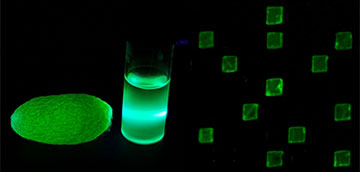
From left to right: an edible, fluorescent silk cocoon; a vial containing silk-protein solution; and a matrix code generated using the proteins from the cocoons. [Image: Adapted from ACS Central Science 2022; doi: 10.1021/acscentsci.1c01233]
The rise of online pharmacies has greatly exacerbated the problem of counterfeit medications, which pose a danger to patient safety and public health. There are roughly 35,000 to 40,000 active online pharmacies worldwide, yet only 3% to 4% of them operate legally.
To help combat this issue, researchers in the United States and the Republic of Korea have developed edible fluorescent tags made of silk that can be placed directly on pills or in a liquid medicine (ACS Cent. Sci., doi: 10.1021/acscentsci.1c01233). The tag features a smartphone-readable matrix code that allows health care providers and even patients themselves to easily authenticate medications.
A better anti-counterfeit system
Currently, most pharmaceutical companies employ barcodes or quick response (QR) codes on packaging to ensure the integrity of their products. However, a more sophisticated and secure anti-counterfeit system would need to focus on individual medicines at the dosage level.
“In retail and hospital pharmacy settings, medicines are separated from the original packaging and are placed into individual doses for patient safety, quality control, delivery and inventory tracking,” says senior author Young L. Kim, a biomedical-engineering professor at Purdue University, USA. “On-dose authentication for solid oral dosage forms or in-dose authentication for liquid dosage forms at the point of medication administration can offer the highest protection.”
Kim and his colleagues set out to create a method of on-dose authentication as easy to use as conventional barcodes and QR codes, but with the added feature of being safe for human consumption. They decided to investigate the use of silk protein produced by silkworms, a material that is edible, digestible and free from toxic elements.
Fluorescent silk proteins
First, the researchers genetically engineered silkworms to produce silk proteins hybridized with cyan, green or red fluorescent proteins. Next, they applied these proteins on a 9-mm-wide film of non-fluorescent white silk in the form of a 7×7 grid to act as a matrix code of information representation and data storage. Lastly, the tags were integrated into medicines having both pill and liquid forms.
A consumer can use a smartphone to complete an authentication process with a custom-built mobile app that scans the edible tag using a set of excitation and emission optical filters. The app authenticates the scanned code and opens an embedded hyperlink to confirm that the product is genuine, featuring specific data such as dosage strength, dosage frequency, warnings and expiration date.
“The next key issue is to achieve scalable manufacturing, as we are talking about a large quantity,” says Kim. “Because barcodes and QR codes are commonly used, the data management and security aspects would be relatively straightforward. [Nevertheless, we] will need industrial collaborations and partnerships with major pharmaceutical companies.”
